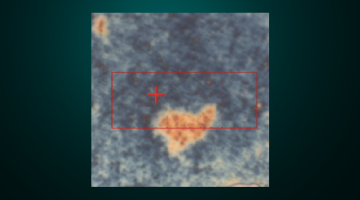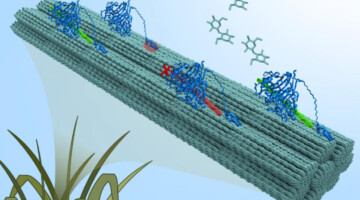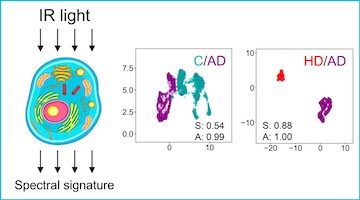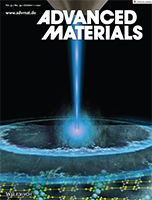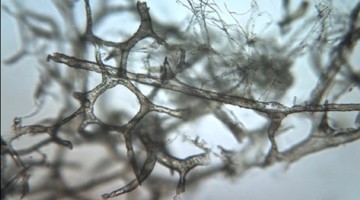A new study illustrates how microbes respond, in real time, to environmental stress, improving the research community’s knowledge of the hidden microbial engines that keep our planet running. Read more »
Tracking the Breakdown of Cellulose at the Micron Scale
A time-resolved study using infrared spectromicroscopy in a carefully controlled environment revealed why enzymes get bogged down when trying to break up cellulose from plants. The work sheds new light on the challenge of extracting the sugars locked up in plants for use in making petroleum-free fuels, chemicals, and medicines. Read more »![]()
![]()
Watching the Enzymes that Convert Plant Fiber into Simple Sugars
Research from Lawrence Berkeley National Laboratory, Lawrence Livermore National Laboratory, and UC Davis sheds new light on how to access the sugars locked up in plants to produce petroleum-free fuels, chemicals, and medicines. The technique used combines a novel microfluidic device and infrared spectroscopy to study how a cellulose-degrading enzyme works in real time. Read more »
Liquid Heterostructures: Generation of Liquid–Liquid Interfaces in Free-Flowing Liquid Sheets
Microscope image of a microfluidic nozzle producing a liquid heterostructure: a layered flat liquid sheet with outer toluene layers and an inner water layer. The colored bands arise from thin film interference, indicating the presence of buried liquid‒liquid interfaces and submicron layer thicknesses. Read more »
Spectral Phenotyping for Early Detection of Alzheimer’s Disease
Early detection of Alzheimer’s disease may soon be within reach, thanks to spectral phenotyping. Using infrared spectroscopy, Berkeley Lab researchers developed this technique to detect the subtle biochemical changes in a “cellular fingerprint” that is characteristic of the devastating disease. Read more »
Cell ‘Fingerprinting’ Could Yield Long-Awaited Alzheimer’s Disease Diagnostic
A new application of infrared spectromicroscopy analyzes cells for signs of Alzheimer’s disease by measuring how the molecules in cells vibrate upon exposure to infrared light. The vibrational profile of each sample is so distinct and the difference between diseased and healthy cell samples is so visible that researchers liken the process to “cellular fingerprinting.” Read more »
Laser-Induced Cooperative Transition in Molecular Electronic Crystal
The cooperative tuning of a supramolecular electronic crystal enables access to a long-lived hidden conducting phase with a broad temperature range. Researchers demonstrate a dynamic and cooperative phase in K-TCNQ, with the control of pulsed electromagnetic excitation. A dedicated charge–spin–lattice decoupling is required to activate and subsequently stabilize the non-equilibrium phase. Read more »
2D Electronics Get an Atomic Tuneup
Researchers demonstrated a promising avenue for controlling atomic ordering in semiconductor alloys by engineering frustrated interactions in a 2D transition metal dichalcogenide (TMD). The work could lead to improved semiconductor performance for next-generation electronics such as optoelectronics, thermoelectrics, and sensors. Read more »
Survival of T. rex Microvascular Structures from Deep Time
Researchers used several analytical techniques at the ALS to demonstrate how soft-tissue structures may be preserved in dinosaur bones, countering long-standing scientific dogma that protein-based body parts cannot survive more than one million years. Read more »
Can Minerals in the Earth’s Lower Mantle Store Water?
Earth is considered a watery planet, simply by virtue of the fact that 71% of its surface is covered by oceans. But researchers have discovered that, in the massive volume of material in Earth’s interior, minerals can serve as an important water reservoir, providing a new perspective on our planet’s water budget. Read more »
